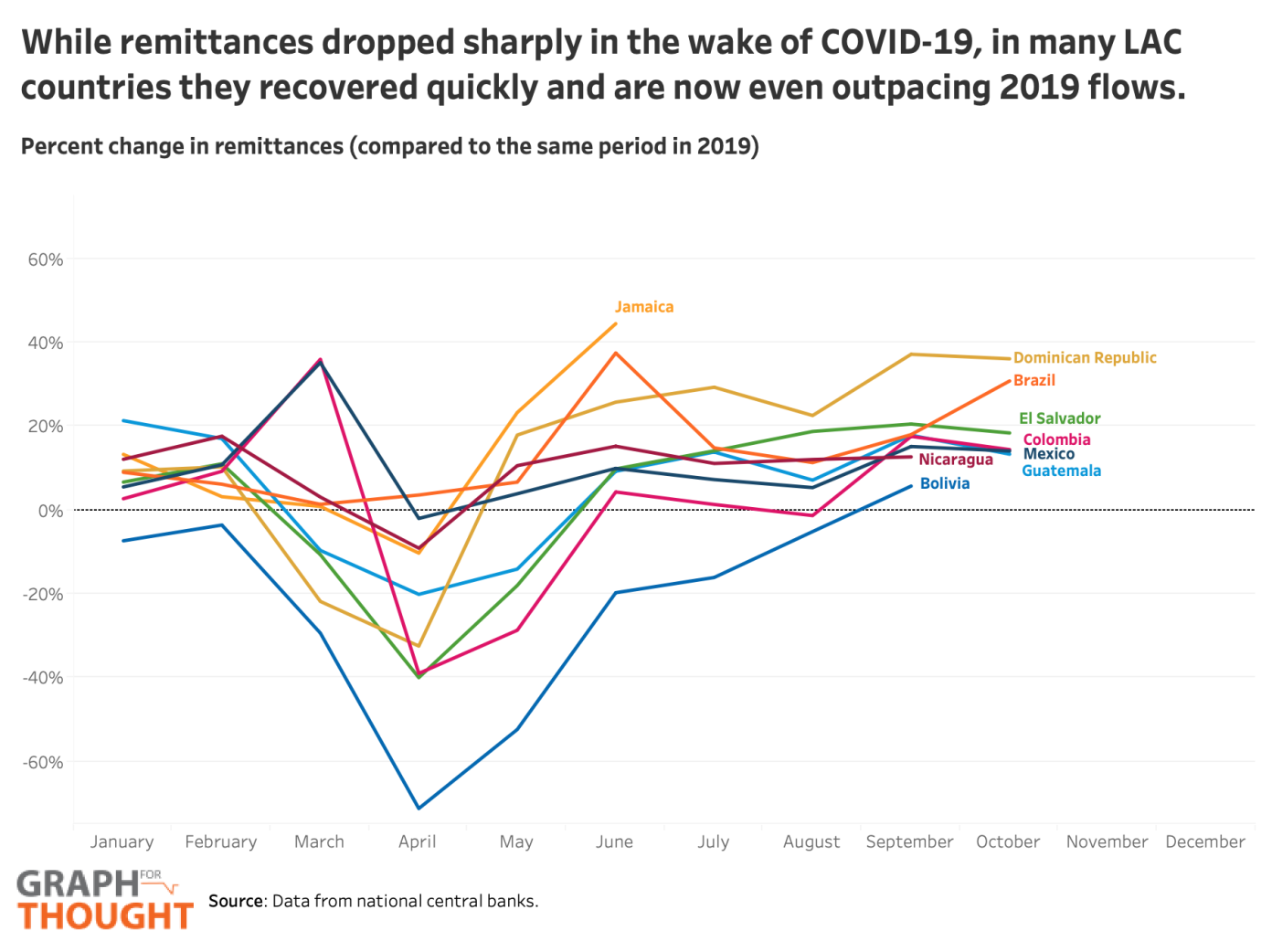Stand by me: COVID-19 and the Resilience of Remittance Flows to LAC
December 2, 2020
In the wake of COVID-19, analysts estimated that remittance flows (money sent home from migrant workers abroad) would face a steep decline. In late April, the World Bank projected an estimated 20% drop in remittances in 2020—which would have made it the “sharpest decline of remittances in recent history.” This was broadly anticipated due to expected losses of employment and/or wage contraction of migrant workers as a result of COVID-19 pressures on the labor market in host countries. This was of particular concern in the LAC region, where remittances are an integral source of income for many households. As I have discussed in a previous #GraphForThought, remittances have been growing steadily in LAC over the past decade—and represent a growing share of GDP in many Central American and Caribbean countries (comprising over 1/3 of GDP in Haiti!).
These models, however, failed to predict the resilience of remittances. This #GraphForThought relies on data from LAC countries’ respective central banks to see what has happened with remittance flows to the region. The graph plots the percent change in remittance inflows compared to the same period in 2019—thereby showing a contraction in remittances when it dips below the 0% line and expansion of remittances when it rises above the 0% line.
When looking at the data, we see a pattern of surprising resilience in most LAC countries. While the shock of COVID-19 did lead to the expected drop-off inflows initially—remittances rebounded quickly, and in many countries are now even outpacing 2019 flows.

The initial drop-off largely took place during the period of March-May, with recovery largely rebounding from June onward. The largest contractions took place in April—with drop-offs ranging from just -2% in Mexico to over -70% in Bolivia. Brazil is the only country in which no contraction was recorded. Moreover, all countries with monthly data had recovered by June—except Bolivia which recovered by September. In all of the countries that “recovered,” flows increased compared to 2019 levels, and have remained higher. Countries such as Mexico (in March), Colombia (in March), Jamaica (in June), Brazil (in June), and Dominican Republic (in September and October) all experienced a month of flows that was more than a third higher than the same period in 2019. Multiple LAC countries have even registered record levels of remittance inflows during COVID-19. For example, Brazil registered a record US$ 317.6 million in August 2020; Colombia registered a record US$715.9 million in March 2020; Dominican Republic registered a record US$827.7 million in July 2020; El Salvador registered a record US$571.4 million in October 2020; Guatemala registered a record US$1,132.9 million in October 2020 and Mexico registered a record US$4,045 million in March 2020.
Why have remittances been so resilient in LAC thus far during COVID-19, defying early predictions? While there are likely many different reasons—recent global analyses (including work from Caron and Tiongson and KNOMAD) point toward key underlying factors. In the context of LAC, the most relevant is that many migrants abroad (this primarily refers to those in the United States—where over 75% of remittances to LAC originate) work in essential sectors, and thus did not see as extensive a job loss as predicted, and some have benefitted from COVID-19 stimulus payments which may have been a boost to their income. According to Kerwin and Warren (2020), “68% percent of all immigrants in the US labor force and 74% of undocumented workers are essential workers, compared to 65% of the native-born labor force.” Moreover, at the national level documented immigrants in the US who earned less than $75,000 in income last year qualified to receive the COVID-19 $1,200 stimulus check—also extending to undocumented immigrants in the state of California (a state where “unauthorized workers make up 10% of the workforce and are overrepresented among essential workers in sectors such as health care and agriculture”).
Research on the role of altruism in driving remittances decisions suggests that remittances tend to be countercyclical—increasing when the situation in the migrants’ country of origin worsens. Given the devasting impact of COVID-19 on many LAC economies, this is likely to be the case in many migrant’s home countries. This altruistic and countercyclical behavior is reflected in the personal narratives of several migrant workers from LAC in the US—who explained to reporters that “I won’t stop helping my mother even if my earnings fall” and that “We are struggling here, but it’s worse in Mexico.”
While it may be too early to know for sure, it would seem that the shock to remittances from COVID-19 may be far less severe than that which resulted from the shock of the 2008-09 financial crisis. In 2008-09, the recession led to a 12% drop in remittances to LAC. Updated predictions from the World Bank are estimating a 0.2 percent drop in 2020 and an 8 percent drop in 2021 for the LAC region. While the remittances have shown remarkable resilience in 2020, it is unclear that this will remain the case until 2021. As countries continue to make progress in the fight against COVID-19, it is critical to remember that many households rely on a global safety net. Making it easier and more affordable to send money digitally across borders is an essential part of making “people-to-people” social protection work effectively and strengthening economic resilience.

 Locations
Locations